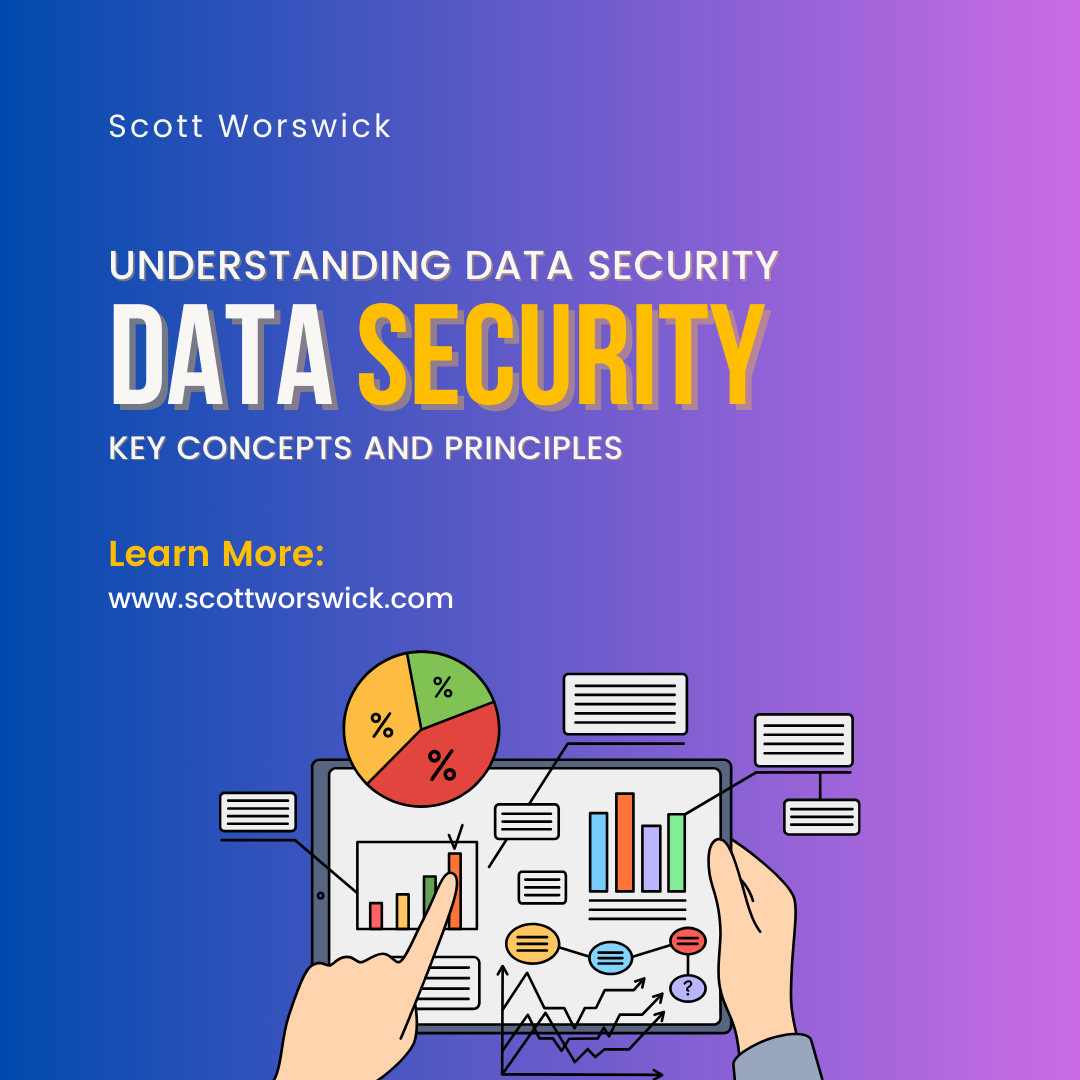In today’s interconnected world, the sheer volume of data generated and exchanged daily is staggering. This digital information is the lifeblood of modern businesses, governments, and personal communications. However, with the increasing reliance on digital systems comes a corresponding rise in threats targeting sensitive information. Understanding data security is crucial for mitigating these risks and ensuring that personal and organizational data remains safe from unauthorized access and malicious attacks. As cyber threats evolve in complexity and frequency, a robust grasp of data security principles becomes indispensable for anyone navigating the digital landscape.
Data security encompasses a wide array of practices and technologies designed to protect digital information throughout its lifecycle. This includes measures to maintain confidentiality, ensuring that sensitive data is only accessible to authorized users; integrity, guaranteeing that the data remains accurate and unaltered; and availability, making sure that information is accessible when needed. By comprehending these key concepts, individuals and organizations can implement effective strategies to safeguard their data against breaches, cyber-attacks, and other threats. In an era where data breaches and cyber-attacks can have devastating consequences, prioritizing data security is not just a technical necessity but also a critical component of maintaining trust and compliance.
As we delve deeper into the core principles and practices of data security, it’s essential to recognize the diverse threats that can compromise data integrity and confidentiality. From cyber-attacks orchestrated by external actors to insider threats within an organization, the landscape of data security challenges is vast and ever-changing. Implementing best practices, such as regular software updates, employee training, and encryption, can significantly enhance data protection efforts. This comprehensive understanding of data security equips individuals and organizations to proactively defend against potential threats, ensuring that sensitive information remains protected in a digital age where data is a valuable asset.
Table of Contents
What is Data Security?
Data security refers to the suite of protective measures and protocols implemented to safeguard digital information from unauthorized access, alteration, or destruction throughout its lifecycle. It encompasses a wide range of strategies, technologies, and best practices designed to ensure that sensitive data remains confidential, accurate, and available to authorized users. With the explosion of digital information in every sector—from personal communications and financial transactions to healthcare records and corporate data—ensuring robust data security has become a top priority. The goal is to prevent data breaches, unauthorized access, and other cyber threats that can lead to significant financial losses, reputational damage, and legal liabilities.
At the heart of data security lies the triad of confidentiality, integrity, and availability, often abbreviated as CIA. Confidentiality ensures that sensitive information is accessible only to those who have been granted explicit permission, typically through the use of encryption, access controls, and stringent authentication mechanisms. Integrity involves maintaining the accuracy and consistency of data over its entire lifecycle, employing techniques such as checksums, hashing, and digital signatures to detect and prevent unauthorized alterations. Availability, on the other hand, ensures that data remains accessible to authorized users when needed, through measures such as redundancy, failover systems, and comprehensive disaster recovery plans. Together, these principles form the foundation of a robust data security framework.
In today’s interconnected digital environment, threats to data security are more prevalent and sophisticated than ever before. Cyber attackers utilize various methods, including malware, ransomware, phishing, and insider threats, to compromise data integrity and confidentiality. To combat these threats, organizations must adopt a proactive and layered approach to data security, often referred to as defense in depth. This involves deploying multiple layers of defense mechanisms, such as firewalls, intrusion detection systems, and multi-factor authentication, to create a comprehensive security posture. By understanding and implementing these core concepts and principles of data security, organizations can better protect their valuable digital assets and maintain the trust of their clients, partners, and stakeholders.
Key Concepts in Data Security
1. Confidentiality
Confidentiality is a cornerstone of data security, focused on ensuring that sensitive information is accessible only to authorized individuals and protected from unauthorized access or disclosure. This principle is crucial in maintaining the privacy of personal data, proprietary business information, and any other type of sensitive data that could be exploited if exposed. To achieve confidentiality, organizations employ a range of technologies and practices designed to control access to information and ensure that only those with the necessary permissions can view or modify it. Effective confidentiality measures are essential for compliance with various regulatory requirements and for maintaining the trust of customers and stakeholders.
Encryption is one of the most powerful tools used to uphold confidentiality. By transforming readable data into an encoded format that can only be deciphered with the correct key, encryption ensures that even if data is intercepted, it remains unintelligible to unauthorized users. Both symmetric encryption (where the same key is used for encryption and decryption) and asymmetric encryption (where different keys are used) play vital roles in protecting data in transit and at rest. For instance, encrypted communications over HTTPS ensure that data exchanged between a user’s browser and a website remains private and secure from eavesdroppers.
Access control mechanisms are another critical aspect of maintaining confidentiality within data security. These mechanisms define who can access specific data and under what conditions. Role-based access control (RBAC) is a common approach, where permissions are assigned to roles rather than individuals, streamlining the process of managing user access. Multi-factor authentication (MFA) adds an additional layer of security by requiring users to verify their identity through multiple methods, such as a password and a fingerprint scan or a security token. This makes it significantly harder for unauthorized individuals to gain access to sensitive information, even if they manage to obtain login credentials.
Ensuring confidentiality also involves regular audits and monitoring to detect and respond to potential breaches. Continuous monitoring systems can flag unusual access patterns or unauthorized attempts to access data, enabling swift action to mitigate potential threats. Security information and event management (SIEM) systems aggregate and analyze data from various sources within an organization’s IT environment to provide real-time insights and alerts. Regular audits and assessments help identify vulnerabilities and ensure that access controls and encryption methods are up-to-date and effective. By prioritizing these strategies, organizations can significantly enhance the confidentiality of their data, a crucial component of comprehensive data security measures.
2. Integrity
Integrity is a fundamental aspect of data security that ensures the accuracy and consistency of data throughout its lifecycle. Maintaining data integrity means that information remains unaltered during storage, transmission, and processing, except by authorized actions. This is crucial because any unauthorized modifications can compromise the reliability of the data, leading to erroneous decisions, loss of trust, and potentially severe consequences for businesses and individuals. Ensuring data integrity involves implementing various technical and procedural safeguards to detect and prevent unauthorized changes, thereby maintaining the trustworthiness of the information.
One of the primary techniques used to ensure data integrity is hashing. A hash function generates a unique, fixed-size string of characters (the hash) from data input. Even the slightest change in the input data will produce a significantly different hash, making it easy to detect any alterations. For instance, during data transmission, the sender can generate a hash of the original data and send it along with the data. The receiver can then generate a hash from the received data and compare it with the sent hash. If they match, the data has not been altered. This method is commonly used in digital signatures and data integrity verification processes.
Additionally, digital signatures and checksums are essential tools for maintaining data integrity. A digital signature, created using public key cryptography, not only verifies the identity of the sender but also ensures that the data has not been altered. Checksums are simpler methods that add up the binary values of data and store the result, which can be compared later to ensure no modifications have occurred. Beyond technical measures, maintaining data integrity also requires strict access controls and audit trails. These procedural measures ensure that only authorized personnel can modify data and that all changes are logged and monitored. By combining these technical and procedural safeguards, organizations can effectively protect the integrity of their data, a critical component of overall data security.
3. Availability
Availability is a crucial element of data security that ensures information and resources are accessible to authorized users whenever needed. This principle is vital for maintaining operational continuity and ensuring that critical services and data are available to users without interruption. High availability is achieved through a combination of hardware and software solutions, as well as strategic planning and regular maintenance. Ensuring availability means that systems are resilient against failures, whether they are due to hardware malfunctions, software bugs, cyber-attacks, or natural disasters.
One of the primary methods to ensure availability is through redundancy. Redundancy involves having multiple instances of critical system components, such as servers, storage devices, and network connections, so that if one component fails, another can immediately take its place. This approach is often implemented through load balancing and failover mechanisms, which distribute workloads across multiple systems and automatically switch to a backup system if the primary one fails. Additionally, regular data backups are essential for restoring data quickly in the event of a loss, ensuring that downtime is minimized and data remains accessible.
Disaster recovery planning is another key aspect of maintaining availability. A comprehensive disaster recovery plan outlines the procedures and processes to follow in the event of a catastrophic failure, ensuring that data and services can be restored as quickly as possible. This includes regular testing and updating of the plan to address new potential threats and vulnerabilities. Moreover, implementing robust monitoring and alerting systems allows organizations to detect and respond to issues before they escalate into major outages. By prioritizing availability alongside other principles of data security, organizations can ensure that their operations remain smooth and that users can rely on uninterrupted access to critical information and services.
Core Principles of Data Security
1. Least Privilege
The principle of least privilege is a foundational concept in data security, advocating that users and systems should have the minimum levels of access—or privileges—necessary to perform their functions. This approach significantly reduces the risk of accidental or malicious damage to sensitive data and critical systems. By limiting access rights, organizations can better protect their assets from internal and external threats, ensuring that users only interact with data and resources essential to their roles. This not only enhances security but also improves accountability, as it is easier to trace actions back to specific individuals or systems.
Implementing least privilege involves a meticulous process of defining and assigning permissions based on the roles and responsibilities of each user or system. Role-based access control (RBAC) is a common method used to achieve this, where permissions are grouped into roles corresponding to different job functions. For instance, an employee in the finance department would have access to financial records but not to the HR system. This granular level of control ensures that even if an account is compromised, the potential damage is limited to a small part of the system. Regularly reviewing and updating these roles and permissions is crucial, especially when employees change roles or leave the organization.
Another critical aspect of least privilege is the use of just-in-time (JIT) access. JIT access grants permissions temporarily, only when needed, and automatically revokes them after a specified period. This reduces the window of opportunity for misuse of elevated privileges. For example, a system administrator might receive elevated access to perform a specific task, but this access would expire once the task is completed. This method is particularly effective in dynamic environments where access needs can frequently change. Combining JIT with comprehensive logging and monitoring further enhances security by providing a clear audit trail of who accessed what and when.
The principle of least privilege also extends to system processes and applications. Only essential services and applications should run with the privileges required for their operations, and unnecessary services should be disabled. This minimizes the attack surface, reducing the chances of exploitation by malicious actors. Implementing this principle requires a thorough understanding of the organization’s systems and regular audits to identify and address any deviations. By adhering to the principle of least privilege, organizations can significantly bolster their data security posture, ensuring that access rights are tightly controlled and continuously monitored.
2. Defense in Depth
Defense in depth is a comprehensive approach to data security that employs multiple layers of protection to safeguard information. This strategy acknowledges that no single security measure can be foolproof and that overlapping defenses are necessary to provide robust protection against a wide array of threats. By implementing a variety of security controls at different levels—such as network, application, endpoint, and data layers—organizations can create a multifaceted barrier that significantly reduces the risk of unauthorized access and data breaches. This layered defense mechanism ensures that even if one security measure fails, additional layers continue to provide protection.
At the network level, firewalls, intrusion detection systems (IDS), and intrusion prevention systems (IPS) serve as the first line of defense by monitoring and controlling incoming and outgoing network traffic. These systems are designed to detect and block malicious activities before they can penetrate deeper into the network. Additionally, implementing network segmentation can limit the spread of potential breaches by isolating critical systems and data into separate, secure segments. This compartmentalization means that even if an attacker gains access to one segment, they cannot easily move laterally to other parts of the network.
On the application and endpoint levels, defense in depth includes using secure coding practices, regular software updates, and patch management to mitigate vulnerabilities. Application firewalls and anti-malware software further protect against exploits and malicious software. Multi-factor authentication (MFA) and strong access controls enhance security by ensuring that only authorized users can access sensitive systems and data. Data encryption, both at rest and in transit, adds an additional layer of security by making intercepted data unreadable to unauthorized users. Regular security training and awareness programs for employees ensure that human factors do not become the weakest link in the security chain. By integrating these diverse protective measures, the defense in depth approach provides a robust and resilient data security framework that adapts to evolving threats and minimizes the risk of data breaches.
3. Security by Design
Security by design is an essential principle in data security, emphasizing the integration of security measures throughout the entire development process of systems and applications. Rather than treating security as an afterthought or a final step before deployment, this approach ensures that security considerations are embedded from the very beginning. By incorporating security features into the initial design and architecture, organizations can proactively address potential vulnerabilities and create more robust and resilient systems. This proactive strategy not only mitigates risks more effectively but also reduces the costs and complexities associated with retrofitting security solutions after a system is already in place.
One of the key aspects of security by design is implementing secure coding practices. Developers are trained to write code that anticipates and defends against common threats, such as SQL injection, cross-site scripting (XSS), and buffer overflows. Regular code reviews and static analysis tools are used to identify and fix vulnerabilities early in the development cycle. Additionally, employing threat modeling techniques allows teams to anticipate potential attack vectors and design appropriate countermeasures. This forward-thinking approach ensures that security is an integral part of the development process, resulting in applications that are inherently more secure.
Another crucial component of security by design is conducting rigorous security testing throughout the development lifecycle. This includes both automated and manual testing methods, such as penetration testing, vulnerability scanning, and security audits. Continuous integration and continuous deployment (CI/CD) pipelines can incorporate security testing tools to ensure that every code change is evaluated for potential security issues before it is merged into the main codebase. Moreover, adhering to industry standards and best practices, such as those outlined by the Open Web Application Security Project (OWASP), helps ensure that security measures are comprehensive and up-to-date. By adopting security by design, organizations can build systems that are not only functional and efficient but also fortified against the myriad of threats they may face, thereby enhancing their overall data security posture.
Common Threats to Data Security
1. Cyber Attacks
Cyber attacks represent one of the most significant challenges to modern data security, posing threats to individuals, businesses, and governments worldwide. These attacks encompass a wide range of malicious activities, including but not limited to phishing, malware, ransomware, and denial-of-service (DoS) attacks. Each type of cyber attack targets vulnerabilities within information systems, aiming to compromise data integrity, confidentiality, or availability. Understanding the methods and motivations behind cyber attacks is paramount for developing effective defense strategies and safeguarding sensitive information against malicious exploitation.
Phishing attacks are among the most prevalent forms of cyber attacks, leveraging social engineering techniques to trick individuals into divulging confidential information or clicking on malicious links. These attacks often impersonate trusted entities, such as financial institutions or reputable companies, in emails, text messages, or social media messages. Once a victim interacts with a phishing attempt, they may inadvertently disclose login credentials, financial details, or other sensitive information, which can then be used for identity theft, fraud, or further cyber exploits. Combatting phishing requires a combination of user education, spam filters, and email authentication protocols to detect and mitigate these deceptive tactics.
Ransomware attacks pose a significant threat to data security, encrypting valuable files or systems and demanding payment for their release. These attacks can have devastating consequences for businesses, disrupting operations, causing financial losses, and damaging reputations. Ransomware typically spreads through phishing emails, malicious attachments, or exploiting vulnerabilities in software or network configurations. Preventing ransomware involves implementing robust backup solutions, maintaining up-to-date software, and employing advanced threat detection and response mechanisms. Additionally, user awareness training and strict access controls can help mitigate the risk of ransomware infections, ensuring that organizations are better prepared to defend against this pervasive cyber threat.
2. Insider Threats
Insider threats represent a significant and often underestimated risk to data security, stemming from individuals within an organization who misuse their access to sensitive information for malicious purposes. Unlike external cyber attacks, insider threats can be particularly challenging to detect and mitigate, as the perpetrators already have legitimate access to the data they seek to exploit. These threats can take various forms, including intentional data theft, sabotage, espionage, or unintentional actions resulting from negligence or ignorance. Understanding the motivations and behaviors of insiders is essential for implementing effective security measures that protect against internal threats while maintaining trust and collaboration within the organization.
One of the most common types of insider threats is data exfiltration, where employees or contractors intentionally steal sensitive information for personal gain or to sell to competitors. This can include intellectual property, customer data, financial records, or trade secrets. Insiders may exploit their knowledge of the organization’s systems and processes to bypass security controls and evade detection. Additionally, disgruntled employees or those facing financial difficulties may seek to harm the organization by leaking confidential information or sabotaging critical systems. Preventing data exfiltration requires a combination of access controls, monitoring tools, and employee awareness programs to identify suspicious behavior and intervene before significant damage occurs.
Unintentional insider threats, often resulting from human error or ignorance, can also pose significant risks to data security. Employees may inadvertently expose sensitive information through careless actions, such as sending emails to the wrong recipients, falling victim to phishing scams, or improperly configuring security settings. Insider negligence can lead to data breaches, compliance violations, and reputational damage for organizations. Addressing unintentional insider threats requires comprehensive training and awareness programs that educate employees about data security best practices and the potential consequences of their actions. Additionally, implementing data loss prevention (DLP) solutions and encryption technologies can help mitigate the risk of accidental data exposure and ensure that sensitive information remains protected against both internal and external threats.
3. Data Breaches
Data breaches represent one of the most pressing concerns in the realm of data security, posing significant risks to individuals, organizations, and society as a whole. A data breach occurs when sensitive information is accessed, disclosed, or used by unauthorized parties without permission. These breaches can result from a variety of factors, including cyber attacks, insider threats, human error, or system vulnerabilities. The consequences of a data breach can be severe, ranging from financial losses and legal liabilities to reputational damage and loss of customer trust. Understanding the causes and impacts of data breaches is essential for developing effective prevention and response strategies to mitigate these risks.
Cyber attacks are a primary cause of data breaches, with hackers exploiting vulnerabilities in systems or networks to gain unauthorized access to sensitive information. These attacks can take various forms, such as malware infections, phishing scams, or exploiting weak passwords. Once inside a network, attackers may exfiltrate data, install ransomware, or disrupt operations, causing widespread damage and disruption. Preventing data breaches from cyber attacks requires a multi-layered approach to security, including robust firewalls, intrusion detection systems, encryption technologies, and regular security updates. Additionally, proactive monitoring and threat intelligence can help identify and thwart potential attacks before they escalate into full-blown breaches.
Insider threats also pose significant risks for data security, with employees, contractors, or trusted partners misusing their access privileges to steal or misuse sensitive information. Whether through intentional data theft, negligence, or unintentional actions, insiders can inadvertently expose organizations to data breaches and regulatory penalties. Preventing insider threats requires implementing strong access controls, monitoring user activities, and conducting regular security training and awareness programs to educate employees about the importance of data security and the potential consequences of their actions. By addressing both external and internal threats, organizations can better protect themselves against data breaches and minimize the impact on their operations and stakeholders.
Best Practices for Enhancing Data Security
1. Regular Updates and Patching
Regular updates and patching are critical components of data security, essential for mitigating vulnerabilities and protecting systems and software from exploitation by cyber attackers. Software vulnerabilities are discovered regularly, and software vendors release patches and updates to address these vulnerabilities and improve overall security. Failure to apply these patches promptly leaves systems exposed to potential exploits, increasing the risk of data breaches, system compromise, and unauthorized access. By prioritizing regular updates and patching, organizations can strengthen their defenses against emerging threats and reduce the likelihood of security incidents that could compromise sensitive information.
Patch management involves the systematic process of identifying, evaluating, and applying software updates and patches to mitigate known vulnerabilities. This process encompasses both operating systems and third-party applications, as vulnerabilities can exist in any software component. Automated patch management solutions can streamline this process, ensuring that patches are applied promptly and consistently across all systems in the organization’s network. Regular updates not only address known security vulnerabilities but also introduce new features, performance improvements, and compatibility enhancements, further enhancing the overall security and functionality of systems and applications.
Furthermore, regular updates and patching are essential for maintaining compliance with regulatory requirements and industry standards related to data security. Many regulations, such as the General Data Protection Regulation (GDPR), Payment Card Industry Data Security Standard (PCI DSS), and Health Insurance Portability and Accountability Act (HIPAA), mandate regular security updates and patch management as part of a comprehensive data protection strategy. Failure to comply with these requirements can result in severe financial penalties, legal liabilities, and reputational damage for organizations. By staying proactive and vigilant in applying updates and patches, organizations can demonstrate their commitment to data security and compliance, safeguarding sensitive information and maintaining the trust of their customers and stakeholders.
2. Employee Training and Awareness
Employee training and awareness play a pivotal role in enhancing data security within organizations, as human error remains one of the leading causes of security breaches. Educating employees about data security best practices, policies, and procedures empowers them to recognize potential threats, mitigate risks, and respond effectively to security incidents. Training programs should cover a wide range of topics, including password hygiene, phishing awareness, social engineering tactics, secure data handling practices, and compliance requirements. By cultivating a culture of security awareness, organizations can transform employees into proactive defenders of data security, reducing the likelihood of human-related security incidents and strengthening overall resilience against cyber threats.
Regular training and awareness initiatives are essential for keeping employees informed about emerging threats and evolving security risks. Cyber attackers continually refine their tactics and techniques to bypass security measures and exploit human vulnerabilities, making ongoing education crucial for staying ahead of potential threats. Training sessions, workshops, and simulated phishing exercises can provide employees with hands-on experience in recognizing and responding to various types of security threats. Additionally, incorporating real-world examples and case studies into training materials can help employees understand the potential consequences of security lapses and the importance of adhering to data security policies and procedures.
Moreover, fostering a culture of continuous learning and improvement is essential for sustaining effective data security practices over time. Encouraging open communication channels, providing regular feedback, and rewarding proactive security behaviors can reinforce the importance of data security throughout the organization. Additionally, establishing clear reporting channels for security incidents and encouraging employees to report suspicious activities promptly empowers organizations to respond swiftly to potential threats and mitigate their impact. By investing in comprehensive employee training and awareness programs, organizations can build a resilient human firewall that complements technical security measures, enhancing overall data security posture and reducing the risk of security breaches and data loss.
3. Data Encryption
Data encryption is a foundational technique in data security, essential for protecting sensitive information from unauthorized access or interception. Encryption involves converting plaintext data into ciphertext using cryptographic algorithms and keys, rendering it unintelligible to anyone without the corresponding decryption key. Whether data is at rest, in transit, or in use, encryption provides an additional layer of security, ensuring that even if intercepted or compromised, the data remains unreadable and unusable to unauthorized parties. By encrypting data, organizations can mitigate the risk of data breaches, safeguard privacy, and maintain compliance with regulatory requirements.
One of the primary benefits of data encryption is its versatility, as it can be applied to various types of data and communication channels. For instance, end-to-end encryption secures data as it travels between endpoints, such as between a user’s device and a web server, ensuring that only the sender and intended recipient can decipher the information. Full disk encryption protects data stored on devices such as laptops, smartphones, and servers, preventing unauthorized access in case of theft or loss. Additionally, database encryption and file-level encryption provide granular control over access to specific datasets or files, ensuring that sensitive information remains protected from unauthorized users or internal threats.
Implementing data encryption requires careful consideration of encryption algorithms, key management practices, and integration with existing systems and workflows. Strong encryption algorithms, such as Advanced Encryption Standard (AES), provide robust protection against cryptographic attacks and brute-force decryption attempts. Effective key management strategies, including key generation, storage, rotation, and revocation, are essential for ensuring the security and integrity of encryption keys. Moreover, integrating encryption seamlessly into existing data storage, transmission, and processing workflows ensures minimal disruption while maximizing data security. By adopting data encryption as a core component of their data security strategy, organizations can enhance confidentiality, integrity, and compliance while minimizing the risk of data breaches and unauthorized access.
Conclusion
In conclusion, understanding the key concepts and principles of data security is paramount in today’s digital landscape, where the protection of sensitive information is essential for individuals, businesses, and governments alike. By embracing a multifaceted approach that encompasses confidentiality, integrity, availability, and other core principles, organizations can create robust defenses against cyber threats and mitigate the risk of data breaches. From implementing encryption and access controls to fostering a culture of security awareness and conducting regular updates and patching, a comprehensive data security strategy requires proactive measures at every level to safeguard valuable data assets.
Data security is not merely a technical necessity but also a fundamental aspect of maintaining trust, compliance, and operational continuity in an interconnected world. As cyber threats continue to evolve in complexity and frequency, organizations must remain vigilant, adaptive, and proactive in their approach to protecting sensitive information. By investing in ongoing education, training, and technological solutions, organizations can empower employees, strengthen defenses, and effectively respond to emerging threats. Ultimately, a robust understanding of data security concepts and principles serves as the foundation for building resilience, maintaining privacy, and safeguarding the integrity of data in an era where digital assets are increasingly valuable and vulnerable.







Pingback: The Importance of Data Security in Protecting Personal Information -